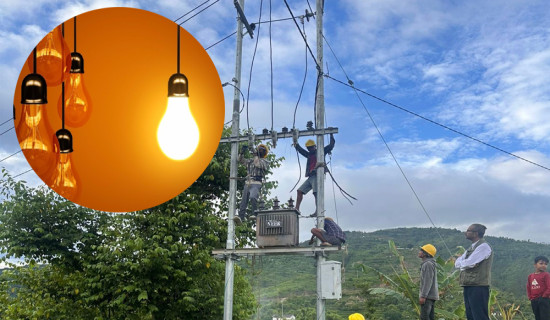- Wednesday, 26 November 2025
Promoting Electric Evolution In Nepal
The government of Nepal has adopted a policy of electrifying transport over the years. Accordingly, general people and public transport operators (PTOs) have been incentivised to use electric vehicles (EVs). Vehicles that run on petroleum products, petrol and diesel, are found to pollute the air by contributing to greenhouse gas emissions. In Nepal, the transport sector contributes as much as 36 per cent to greenhouse gas emissions on an annual basis. The policy of promoting EVs is relevant at a time when many countries around the world are striving to achieve zero emissions by 2050. In a cash-strapped country like Nepal, the promotion of EVs will slash the trade deficit. Nepal has to import petroleum products from India. By promoting EV technology, the cost of importing petroleum products can be drastically reduced.
Under Nepal’s second Nationally Determined Contributions (NDCs), 20 per cent of public transport vehicles will have to be EVs by 2025. Nepal is rich in hydropower and in recent years, remarkable progress in the sector has been achieved. In 2023, the country notched up the net annual surplus of electricity from hydropower for the first time. Without a doubt, surplus electricity can be generated from hydropower and both domestic consumption and exports can be ratcheted up in the near future. On the domestic front, electricity can be used for cooking, lighting and other purposes. It can also be used for electrifying transport, both public and private.
Bright prospects
Considering bright prospects for a surge in hydropower and spiking air pollution, there is a need for encouraging EVs in Nepal. However, progress in the EV sector is not copacetic. EVs are relatively new in Nepal. New EV technology is seen as unreliable and risky by people and PTOs. The upfront cost involved in purchasing EVs is high. There are ordeals of charging EVs as charging stations are few and far between. Some banks and financial institutions (BFIs) do not take the creditworthiness of PTOs positively. Moreover, the government’s policy towards EVS is not stable.
Electric evolution in Nepal began in the 1970s when trolley buses plied the roads of Kathmandu. The trolley buses were operated by electricity and were a new experience for the public. Later, Safa tempos (auto-rickshaws) were launched. Both trolley buses and Safa tempos were eco-friendly. Both were supported by tax cuts and loan incentives, a result of the government’s positive policy. However, it is unfortunate that such a form of transport could not be sustained what with technical (battery) flaws and what with the government’s policy of making huge imports of petroleum products from India. Had such a form of transport been sustained, Nepal would have made remarkable headway in electric transport. In fact, successive governments have not been able to adopt stable policy in any sector.
The government has made a broad strategic plan of replacing 90 per cent of the vehicles with EVs by 2030. The target of supplanting 20 per cent of public vehicles with EVs by 2025 seems unachievable. However, the government should pull out all the stops to achieve its 2030 target. For this, incentives like tax rebates should be in place. Further, charging stations need to be installed in every nook and corner of the country. There are complaints about hassles about charging vehicles while on long tours owing to the unavailability of charging stations. The government is, however, expanding EV infrastructure all over the country by installing charging stations under public-private partnerships. Sajha Yatayat is also working towards improving public transport. Some taxicabs have also been converted into e-taxicabs. The government has made it mandatory for service stations to install charging stations.
EV infrastructure
With the expansion of EVs in Nepal, the issue of e-waste disposal will increase in the future. Batteries have to be replaced on EVs after certain years. Such batteries are far more expensive than the ones used on petrol or diesel vehicles. E-waste is pernicious to the environment. So battery replacement and e-waste disposal may be an issue in the future. Alternative fuels like hydrogen and biofuels may be used to run vehicles. The government should also pay attention to such alternatives. In the budget for the fiscal year 2023/24, the government introduced incentives for the establishment of EV manufacturing and assembly plants along with tax subsidies and land leases. However, EVs were subjected to high taxes. In the budget for the next fiscal year (2024/25), the government has increased excise duties and internal taxes on EVs by five to 20 per cent. On the one hand, the government has been making efforts to increase the share of EVs on the roads, while on the other taxes are being raised. The policy of the government seems inconsistent.
With a surge in taxes, both the public and PTOs have been dissuaded from purchasing EVs. When the prices of EVs and petrol or diesel vehicles are more or less the same, it is evident that the latter will be preferred to the former. The government should realise that the loss of revenue from taxes on EVs can be offset by slashing the cost of importing petroleum products. If the government keeps on increasing taxes, its target of electrifying 90 per cent of the vehicles by 2030 will be just a will-o’-the-wisp. In fact, the government is running on taxes, remittances and foreign grants/aid. The government should slough off its tax-minded mentality and consider what the promotion of EVs has in store. On the one hand, EV technology will enable people to enjoy the full potential of electricity generated from hydropower, while on the other the gaping trade deficit can be drastically retrenched by reducing the import of petroleum products. So the government should adopt a pro-EV policy without delay.
(Maharjan has been regularly writing on contemporary issues for this daily since 2000.)
















